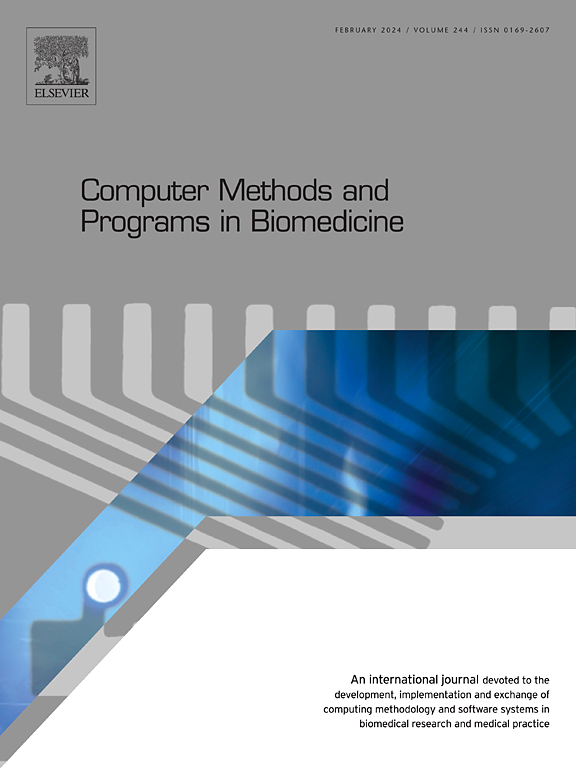A practical strategy for data assimilation of cerebral intra-aneurysmal flows using a variational method with boundary control of velocity
IF 4.9
2区 医学
Q1 COMPUTER SCIENCE, INTERDISCIPLINARY APPLICATIONS
引用次数: 0
Abstract
Background and objective
Evaluation of hemodynamics is crucial to predict growth and rupture of cerebral aneurysms. Variational data assimilation (DA) is a powerful tool to characterize patient-specific intra-aneurysmal flows. The DA inversely estimates a boundary condition in fluid equations using personalized flow data; however, its high computational cost in optimization problems makes its use impractical.
Methods
This study proposes a practical strategy for the DA to evaluate patient-specific intra-aneurysmal flows. To estimate personalized flows, a variational DA was combined with computational fluid dynamics (CFD) and four-dimensional flow magnetic resonance imaging (4D flow MRI) for intra-aneurysmal velocity data, and an inverse problem was solved to estimate the spatiotemporal velocity profile at a boundary of the aneurysm neck. To circumvent an ill-posed inverse problem, model order reduction based on a Fourier series expansion was used to describe temporal changes in state variables.
Results
In numerical validation using synthetic data from the CFD, the present DA achieved excellent agreement with the CFD as ground truth, with velocity mismatch within the 4%-7% range. In flow estimations for three patient-specific datasets, the proposed DA shows the velocity mismatch within the 35%-63% range, which is less than half that of the CFD using main vessel branches, and would mitigate unphysical velocity distributions in the 4D flow MRI.
Conclusions
By focusing only on the intra-aneurysmal region, the present strategy based on the DA provides an attractive way to evaluate personalized flows in aneurysms with greater reliability than conventional CFD and better efficiency than existing DA approaches.
用速度边界控制的变分方法同化脑动脉瘤内血流数据的实用策略
背景与目的血流动力学评价是预测脑动脉瘤生长和破裂的关键。变分数据同化(DA)是表征患者特异性动脉瘤内血流的有力工具。利用个性化流动数据反演流体方程的边界条件;然而,它在优化问题上的高计算成本使得它的使用不切实际。方法本研究提出了一种实用的DA评估患者特异性动脉瘤内血流的策略。为了估计个性化流量,将变分DA与计算流体动力学(CFD)和四维流动磁共振成像(4D flow MRI)相结合,获取动脉瘤内速度数据,并求解反问题来估计动脉瘤颈部边界的时空速度剖面。为了避免不适定逆问题,采用基于傅立叶级数展开的模型降阶来描述状态变量的时间变化。结果利用CFD合成数据进行数值验证,所得数据与CFD计算结果吻合较好,速度失配范围在4% ~ 7%之间。在三个特定患者数据集的流量估计中,所提出的DA显示速度不匹配在35%-63%的范围内,不到使用主血管分支的CFD的一半,并且可以减轻4D血流MRI中的非物理速度分布。结论通过只关注动脉瘤内区域,基于DA的策略提供了一种有吸引力的方法来评估动脉瘤内的个性化血流,比传统的CFD更可靠,比现有的DA方法效率更高。
本文章由计算机程序翻译,如有差异,请以英文原文为准。
求助全文
约1分钟内获得全文
求助全文
来源期刊

Computer methods and programs in biomedicine
工程技术-工程:生物医学
CiteScore
12.30
自引率
6.60%
发文量
601
审稿时长
135 days
期刊介绍:
To encourage the development of formal computing methods, and their application in biomedical research and medical practice, by illustration of fundamental principles in biomedical informatics research; to stimulate basic research into application software design; to report the state of research of biomedical information processing projects; to report new computer methodologies applied in biomedical areas; the eventual distribution of demonstrable software to avoid duplication of effort; to provide a forum for discussion and improvement of existing software; to optimize contact between national organizations and regional user groups by promoting an international exchange of information on formal methods, standards and software in biomedicine.
Computer Methods and Programs in Biomedicine covers computing methodology and software systems derived from computing science for implementation in all aspects of biomedical research and medical practice. It is designed to serve: biochemists; biologists; geneticists; immunologists; neuroscientists; pharmacologists; toxicologists; clinicians; epidemiologists; psychiatrists; psychologists; cardiologists; chemists; (radio)physicists; computer scientists; programmers and systems analysts; biomedical, clinical, electrical and other engineers; teachers of medical informatics and users of educational software.
 求助内容:
求助内容: 应助结果提醒方式:
应助结果提醒方式:


